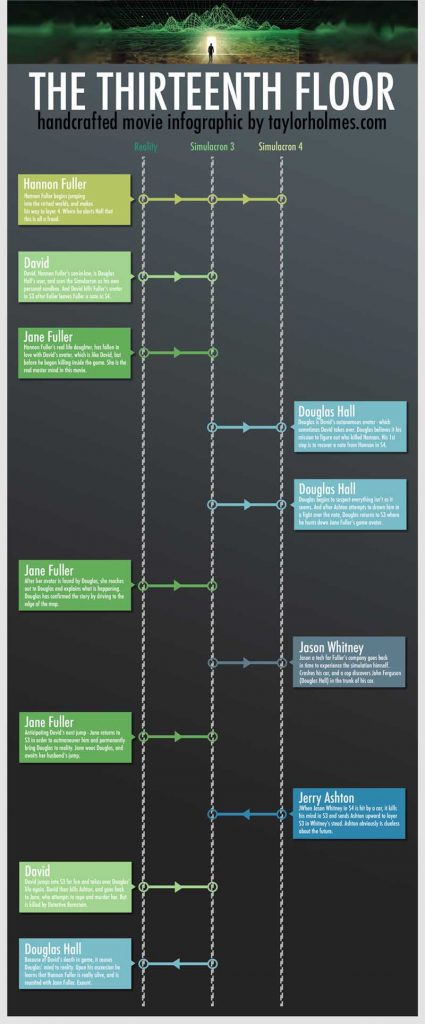I’m utterly shocked – gobsmacked – in awe, with just how well this movie, The Thirteenth Floor holds up over the past 20 years. I seriously consider this a feat on par with how well The Matrix has held up. Sci-Fi movies that owe their sizzle to tech usually age extraordinarily poorly. But no, it really did a great job in all departments. There were no brick phones or horribly flimsy ideas. It really worked well. And the plot, and insights here, were really well done. I can’t recommend it enough – it definitely deserves way more love than it is getting today.
But what is it? For those of you haven’t seen it – The Thirteenth Floor is all about a VR World and a murder of the man who invented the tech. The plot cycles between the 1990’s and 1937. Which, was really well done. The ’37 sections were really really good. But at the end of the day, it was a film noir detective piece, with a VR-World thrown in for good measure. And the tech wasn’t a gimmick either, it was truly integral to the plot. Regardless, if you haven’t seen it yet, you can find it at all the normal streaming spots. (Here is the Netflix link if you are interested.) And here is a trailer to boot. (And you guys are always telling me I never give you nothin’… amazing.)
So, you’ve watched the film, right? It was good, no? I enjoyed it very much. And there is so much going on here, I took the time out to build an in-depth infographic walking us through the various jumps that were made in the movie. But, you cannot, under any circumstance, scroll downward if you haven’t yet watched the movie. Because, WOW, there are a lot of spoilers just beyond the fold right there. Trust me. Go watch it, then come back.
Alright, so normally, the way THiNC. works, is that we get rid of those that haven’t viewed the movie, and then we walk through the movie. Then, after we are all on a common understanding of what actually happened in the movie, we can then talk about the why’s, the how’s, and what nots. But with this movie, it’ll be a little different. I plan to walk us through an infographic I designed. Now, the version of the infographic on this page is too small to read, but if you click it, you’ll get the really big version, which will allow zooming – and therefore – reading. OK? So let’s begin shall we? But please note, I am going to walk you through what actually was happening in the movie, not what the movie is telling you is happening.
The Thirteenth Floor Movie Infographic Walkthrough
Jump 1 – In the year 2021, Hannon Fuller (Mueller-Stahl) is the multi-million dollar inventor of a VR solution called the Simulacron-3 (at least, per the book it was anyway). And Hannon Fuller, as the inventor, is also a regular visitor of his virtual worlds. One of which is set in the 1990’s. And in this particular world, the avatars, or virtual denizens, have invented a VR solution very similar to the Simulacron-3, let’s entitle it, the Simulacron-4. But the S4 is set in 1937. And while visiting S3, Fuller regularly jumps through to 1937 in order to fraternize with the cuter female avatars.
Jump 2 – David (Craig Bierko), from 2021, happens to be the son-in-law of Hannon Fuller, and he likes to hop into the S3 simulation in order to mess around. One detail that is key to understand in the laws and physics of how the Simulacron works is that the VR-denizens just go about living until they are jacked into by a user. At which point, the user takes control of the NPC (non-player-character) and it becomes a player character. OK? The NPC that David jacks into every time, is a character named Douglas Hall. This is a critical distinction to understand.
Now, when David jumps into the game as Douglas, he will regularly murder the various avatars found in the game. One NPC that he decides to murder, is none other than his father-in-law’s NPC Hannon Fuller. This murder sets off an investigation by Detective Larry McBain, in which Hannon Fuller’s personal assistant, Douglas Hall, is the number one suspect. But when avatars get jacked into, they don’t have any memories of what their users do with them, and therefore Douglas has no memory of killing Hannon. Make sense?
Jump 3 – Jane Fuller jacks into the Simulacron 3, and introduces herself to the detective and Douglas as Hannon’s daughter. But she is here for a very specific purpose, though it isn’t very clear at the outset of her arrival into the movie. I personally believe her to be the real mastermind behind everything happening in this movie.
Jump 4 – Douglas Hall, in the Simulacron 3, decides he needs to jack into Hannon’s game (S4) in order to investigate how he died, and to see if he left anything behind. Like, I don’t know…maybe a note? So he heads into the game and starts learning about Hannon’s comings and goings – and he learns that the guy is a real playboy.
Jump 5 – Douglas, after his first jump into S4, and after dealing with the detective back in S3, he heads back into S4 again. This time he enlists the help of Grierson, Hannon Fuller’s avatar, in order to help him see that this is just a game, and to also see if he could remember what Hannon had done while he was there. Eventually he finds that a note was given to Jerry Ashton (the bartender) for him, but Hall and Ashton fight over it, and Jason Whitney (Jerry Ashton’s user in S3) pulls him out of the Simulacron before he could be drowned.
Jump 7 – Yes, I realize this is out of order, but just read the next jump details and you’ll understand. Jason Whitney chooses to go jump into S4 to see what it feels like finally. And when he does, he’s at the wheel of a car, and crashes. A cop pulls Whitney over and finds Douglas Hall’s avatar (John Ferguson) tied up in the trunk.
Jump 6 & 8 – Jump 6 and 8 are probably separate jumps? But there is no indication as to how long someone from reality can jump into S3. Maybe they can stay indefinitely? Anyway, Jane jumps from 2021 into the S3 in order to connect with Douglas Hall. In jump 6 Jane dances with Douglas. In jump 8 they end up sleeping together. And it’s in jump 8 where Douglas learns that it is Jane’s husband who has been murdering people utilizing his Avatar. It’s why he can’t remember anything, and yet all the evidence points directly at him.
Jump 9 – Now, while Jason Whitney is inhabiting S4, he is hit by a car and dies. (And it is this particular moment that invokes the weirdest rule of the entire movie. Which is, when a player inhabits an avatar, and dies, his avatar returns to the player’s body.) Consciousness of the game AI ascends into the player’s body. This is also true from world 4 to world 3.
Jump 10 – And now comes the tricky bit. You paying attention? So David. Wait, let’s not start with David. Let’s start with jumps 6 & 8 – remember that Jane is playing this game at a doctoral level and everyone else is hanging out with Mr. Rogers. Hannon, Hall, Douglas…they literally have no idea how to keep up with Jane. Why? Because, long before the movie timeline even started, she had decided she was done putting up with her cretin husband. Her cretin husband who has been wandering through Simulacron 3 and randomly killing characters with great opprobrium and vitriol. But Jane knows something even Hannon doesn’t. She knows that if she were able to watch for David to jump into game, and if she were able to kill him, she’d kill his consciousness forever. And she also knows that David’s avatar, Hall, is a fairly sweet and kind representation of David. And so, she decides she’ll wait for David to port in, and better than killing him herself, she baits Detective McBain into killing David (Hall) for her. Why? Because he thinks that Hall killed Hannon, and others, and that he was about to kill Jane as well.
Jump 11 – Now, after Detective McBain kills David, it is Douglas Hall’s consciousness that leaps upwards and out into David’s body, just like Jane planned all along. And Douglas is shown 2021 through the back door of Jane’s beachside house. Which, apparently includes lots of cheesy CG of fairly poorly rotoscoped high rises.
The Rules of The Thirteenth Floor
There were a few key rules that happened throughout The Thirteenth Floor. Details you might have sensed, but are inherent laws within the movie and the game.
- Rule 1 – Simulacron 3 is filled with independent thinking and acting avatars that are capable of self direction and autonomy (even autodidaction?)
- Rule 2 – When a user jacks into the game, they take over a self directed avatar, and play as them, but the name changes. Notice how John Ferguson in S4 changed to Douglas Hall when Hall jumped to S4. Also notice how Douglas Hall became David, when David jumped.
- Rule 3 – The technology that makes jumping from Simulacron 3 to 4 only allows for traveling for 2 hours max before it become unstable.
- Rule 4 – When a user is in game, and they die, they also die.
- Rule 5 – When a user death occurs, the avatar replaces them up a level (whether from 4 to 3, or 3 to reality).
What Are We To Make of The Thirteenth Floor?
Can we just take a moment out and reflect on the brilliance of our Jane? You just finished watching this movie, and you rooted for her. You worried she’d make it out alive after her husband attacked her. I mean, after all, her husband is a cold and heartless killer. And yet, the only murderer in this entire movie is Jane. — record scratch —
Think about it. Hannon wasn’t killed by David (via the John Ferguson alt. of Douglas Hall). I mean, he was. But it was all digital. He didn’t kill anyone else…I mean, other than digitally. It’d be like if my wife entered Destiny (which is an Xbox game I have played for years now) and because I am constantly killing other people and bad guys, she were to decide she doesn’t like me anymore. And as a result she expunges my soul, and chooses to spend the rest of her life with my avatar. Wait, what? And Dave is the bad guy here? But through some clever screenplay trickery (a battered wife will always receive all the sympathy points, only thing missing here is a battered puppy) Dave is now our bad guy. Don’t get me wrong, obviously battered wives – in real life – are worth our collective interventions. But I’m just pointing out that, from a moral standpoint, Jane is our evil overlord here.
Not that I’m opposed to that. I’m just pointing out the fact that the only murderer here within this particular movie is Jane. But that she will get away with it because of the fact that David physically didn’t die – just his soul and consciousness. I mean, what does that matter? hahahah.
But the larger philosophical question here is a bigger question of – who are we when we are all alone? Better yet. Who are we when we are surrounded by people we do not know, like in a big city? No, no, no, the question is even more seductive than that. Who are we, when we are surrounded by thousands of people that are not real, and we are the gods that can control anything? What do we do? (It’s a similar question posed by Westworld.) Do we become serial murderers? Rapists? Thieves? Literal gods among men? Or do we live an unassuming life? When the accountability of society and family falls away, who are we really? Which, is really just a question of, who are we in our minds vs. who are we in public. Ask yourself that question – dropped into an island of anonymity and power – how long before you become morally reprehensible?
Final Thoughts on The Thirteenth Floor
There was a metric ton of different things going on in this movie. Of the four main characters, there were actually nine different roles. Craig Bierko, the actor, played Douglas Hall, John Ferguson, and David. Each a distinctly different personality and each a distinctly different motivator and life experience. Armin Mueller-Stahl, the actor, played Hannon Fuller and Grierson. One an inventor of a virtual reality company, the other a peaceful old man just trying to survive this new doubt his wife has about him. Gretchen Mol, the actress, played both Jane Fuller a sophisticated siren, and Natasha Molinaro, the super market attendant. And finally, we had Vincent D’Onofrio, who played both Jason Whitney, the VR Tech, and Jerry Ashton, the slimy bartender. It’s rare to see a movie with this level of complexity played out. Determining who was who and when, wasn’t exactly straight forward and simple. But that made it enormously intriguing. And the fact that the movie still holds up all these years later was rather mind blowing to me. Well done. What did you think of it?
Edited by, CY




